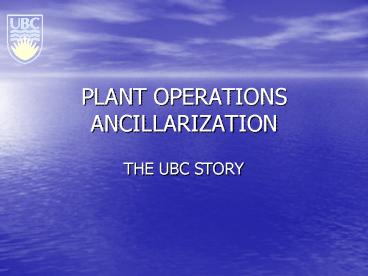PLANT OPERATIONS ANCILLARIZATION - PowerPoint PPT Presentation
1 / 25
Title:
PLANT OPERATIONS ANCILLARIZATION
Description:
Horizontally integrated medium scope firm, regulated ... STRATEGY: PORTER's FORCES. Barrier's to Entry: High. Collective Agreement(s), Economies of Scale, ... – PowerPoint PPT presentation
Number of Views:58
Avg rating:3.0/5.0
Title: PLANT OPERATIONS ANCILLARIZATION
1
PLANT OPERATIONSANCILLARIZATION
- THE UBC STORY
2
Outline
- Strategy,
- Organizational behaviour,
- Finances,
- Marketing,
- Lessons learned
- Next steps
3
STRATEGY Situational Analysis
- Frame the Problem
- Scarce Resource Allocation implication on
academic mission. - Industry Facilities Management
- UBC Plant Operations
- Horizontally integrated medium scope firm,
regulated monopoly owned by UBC. - Director reports to the AVP of Land and Building
Services, and the VP Finance Admin.
4
Product - Customer Matrix
5
STRATEGY
- Profitability Cost Avoidance
- Growth
- Higher service standards,
- New buildings OM, and
- Contracting-in.
- Cyclicality
- Summer renovations,
- Shoulder season maintenance, and
- Aging facilities.
6
STRATEGY PEST Analysis
- Political
- Subject to institutional and government
influences. - Environmental
- Demands for global leadership in sustainability.
- Socio-Economic
- Aging buildings and Deferred Maintenance.
- Opportunity cost associated with the impact of
facilities condition on the recruitment and
retention of researchers, professors, as well as
students. - Construction sector escalation presently
increasing 1 per month. - Technology
- Automation of all work request processes.
7
STRATEGY PORTERs FORCES
- Barriers to Entry High
- Collective Agreement(s),
- Economies of Scale,
- Learning Curve,
- Buyer Power High
- Price Sensitivity,
- Bargaining Leverage, and
- Propensity to substitute.
- Supplier Power Rising
- Importance of Volume,
- Supplier concentration.
- Rivalry Low
- High growth, but
- Monopoly.
- Substitutes High
- Buyer Propensity to switch.
- Relative price.
COMPETITIVENESS DRIVEN BY BUYER POWER, NON-PRICE
COMPETITION (REGULATED)
8
STRATEGY Competition
- Competitor Analysis
- Moving,
- Minor Renovations,
- Project Management,
- Custodial,
- Maintenance,
- Landscape, and
- Waste Management
9
STRATEGY Current Strategy
- Corporate
- Horizontally integrated firm with broad scope
(many products one market), responsible for
stewardship of land and buildings by maximizing
the efficient allocation of scarce resources. - Positioning
- Align services with Academic mission and reality.
- Competitive Stance
- Provide high quality, customer focused
value-added services that are unattainable in the
local marketplace - Functional
- Contract out construction greater than 50,000.
- Reduce waiting times for work done in-house.
10
STRATEGY Value Chain
- Sources of Competitive Advantage
- Resource scheduling of internal trades,
- Utilization of afternoon and graveyard shifts,
- Strong knowledge of campus buildings,
- Attendance management, SafeStart, employee
recognition, and apprenticeship programs, - FME add-ons used for real-time tracking of FFS
hours, productivity, and response times.
11
STRATEGYInternal Characteristics - Aging of
Building Inventory
12
Organizational Behavior
- Culture,
- Academic mission gap,
- Union influence,
- Growth vs. contracting out.
- Employee conflicts (new vs. old),
- Non-negotiable
- Morale,
13
Cultural Shifts Conflicts 1
Morale Participation
Innovation Growth
Productivity Goal Setting
Documentation Control
- Frost, Peter (2004). Organizational Culture. MBA
Integrated Core, Sauder School of Business, - University of British Columbia, Vancouver Canada
14
FINANCES Transitions
- Significant implications
- More work done in-house (1997 to 2000), expanding
workforce. Entire ACA done by in-house crews. - Labour charge-out rates
- Previously underestimated. Only included base
hourly rate and benefit premiums. Productivity
factors such as sick time and vacations as well
as direct costs not included. - GPO under funded
- New expense obligations passed onto the
department without corresponding funding.
15
FINANCES Revenue Growth
16
FINANCES REVENUE SHIFT
17
FINANCES 2003/04 ACTUAL
18
MARKETING Process
- Opportunity Identification (SWOT),
- Market Research (Customer Surveys),
- Forecast demand,
- Segment markets,
- Select the value (competitive positioning),
- Manage the marketing mix (service standards and
price), - Manage the communication mix,
- Manage customer loyalty and retention.
19
MARKETING The Plan
- Current Situation
- Aging Buildings,
- Minimum operational funding,
- Workforce being reduced via natural attrition,
- Opportunity Analysis
- Links with University mission,
- Faculty student recruitment and retention,
- Managing unrealistic and seasonal demands,
- Leadership in transition,
20
MARKETING The Plan
- Objectives (Targets)
- Minimize response times,
- Higher service standard (Level 2),
- Reduce FCI (Facility Condition Index),
- Maximize productivity,
- Marketing Strategy
- Align programs with Academic priorities,
- Manage unrealistic demands,
- Celebrate success,
21
MARKETING The Plan
- Action Programs,
- TREK Initiatives (Classrooms, labs, social
space), - EcoTREK,
- Campus Renewal (FIMP),
- Profit and Loss,
- Zero-based budget,
- Productivity 71 (1390 billable hours per FTE),
- Routine Response less than 3 days
- Eliminate accumulated debt.
22
MARKETING The Plan
- Controls,
- Real-time tracking of
- FFS and GPO hours,
- Productivity, and
- Work request response times.
- Reports
- Budgets (Monthly),
- Annual Forecasts (Quarterly),
23
LESSONS LEARNED
- Ensure the ancillary model encompasses an
integrated approach, - leverage and anticipate implications of cultural
conflicts and shifts. - Balance financial pros and cons,
- Transparency and resilience.
24
NEXT STEPS
- Foster departmental relationships,
- Align value chain advantages with product
positioning (reduce costs vs. add value), - Enhance strategic alliances,
- Implementation of plans.
25
Thank you
- Contact Information
- David Woodson,
- Associate Director Operations Engineering,
- University of British Columbia
- David.woodson_at_ubc.ca
- (604) 822 - 2773































